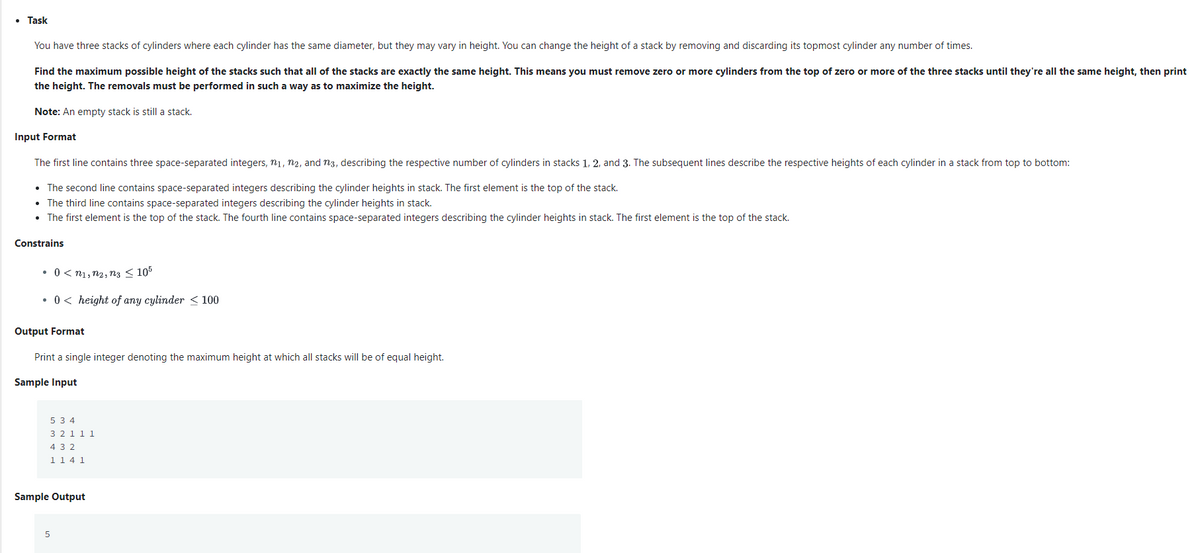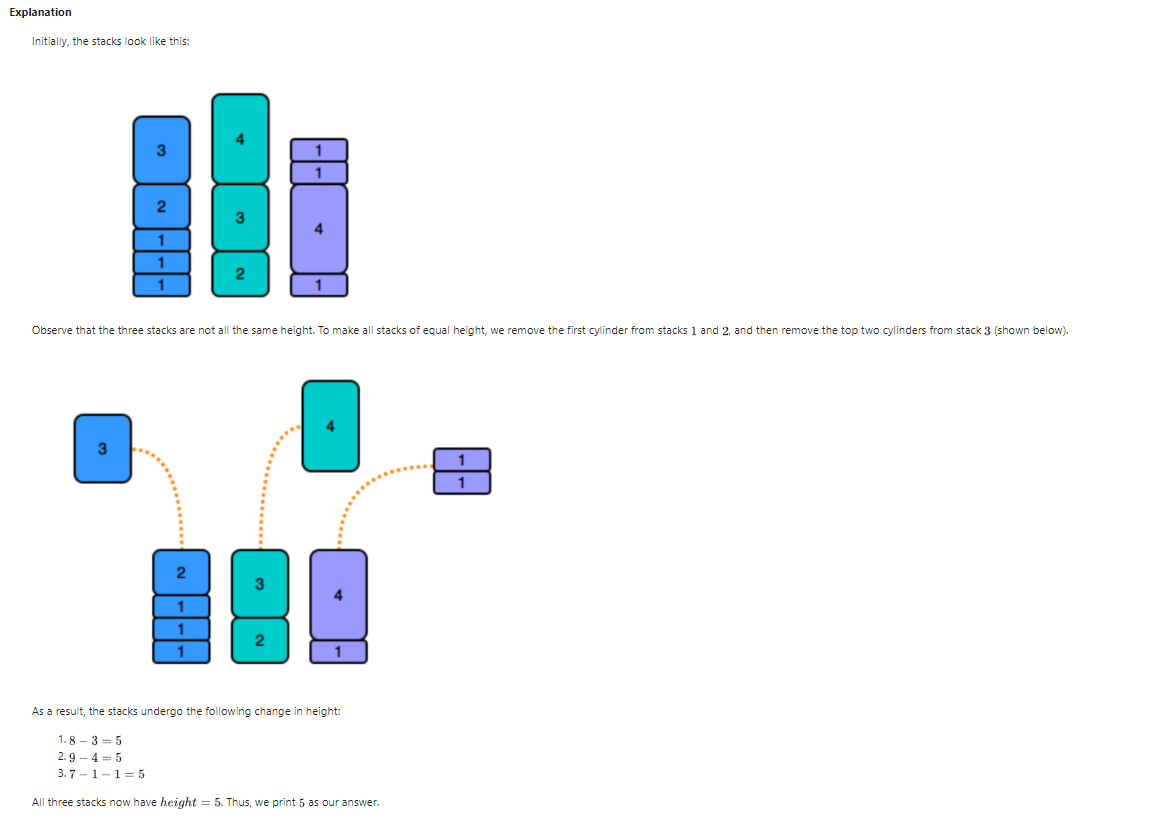• Task You have three stacks of cylinders where each cylinder has the same diameter, but they may vary in height. You can change the height of a stack by removing and discarding its topmost cylinder any number of times. Find the maximum possible height of the stacks such that all of the stacks are exactly the same height. This means you must remove zero the height. The removals must be performed in such a way as to maximize the height. more cylinders from the top of zero or more of the three stacks until they're all the same height, then print Note: An empty stack is still a stack. Input Format The first line contains three space-separated integers, n1, n2, and ng, describing the respective number of cylinders in stacks 1. 2. and 3. The subsequent lines describe the respective heights of each cylinder in a stack from top to bottom: • The second line contains space-separated integers describing the cylinder heights in stack. The first element is the top of the stack. The third line contains space-separated integers describing the cylinder heights in stack. The first element is the top of the stack. The fourth line contains space-separated integers describing the cylinder heights in stack. The first element is the top of the stack. Constrains •0
• Task You have three stacks of cylinders where each cylinder has the same diameter, but they may vary in height. You can change the height of a stack by removing and discarding its topmost cylinder any number of times. Find the maximum possible height of the stacks such that all of the stacks are exactly the same height. This means you must remove zero the height. The removals must be performed in such a way as to maximize the height. more cylinders from the top of zero or more of the three stacks until they're all the same height, then print Note: An empty stack is still a stack. Input Format The first line contains three space-separated integers, n1, n2, and ng, describing the respective number of cylinders in stacks 1. 2. and 3. The subsequent lines describe the respective heights of each cylinder in a stack from top to bottom: • The second line contains space-separated integers describing the cylinder heights in stack. The first element is the top of the stack. The third line contains space-separated integers describing the cylinder heights in stack. The first element is the top of the stack. The fourth line contains space-separated integers describing the cylinder heights in stack. The first element is the top of the stack. Constrains •0
C++ Programming: From Problem Analysis to Program Design
8th Edition
ISBN:9781337102087
Author:D. S. Malik
Publisher:D. S. Malik
Chapter18: Stacks And Queues
Section: Chapter Questions
Problem 16PE:
The implementation of a queue in an array, as given in this chapter, uses the variable count to...
Related questions
Question
100%
PYTHON: Stacks and Queues

Transcribed Image Text:• Task
You have three stacks of cylinders where each cylinder has the same diameter, but they may vary in height. You can change the height of a stack by removing and discarding its topmost cylinder any number of times.
Find the maximum possible height of the stacks such that all of the stacks are exactly the same height. This means you must remove zero or more cylinders from the top of zero or more of the three stacks until they're all the same height, then print
the height. The removals must be performed in such a way as to maximize the height.
Note: An empty stack is still a stack.
Input Format
The first line contains three space-separated integers, n1, n2, and n3, describing the respective number of cylinders in stacks 1, 2, and 3. The subsequent lines describe the respective heights of each cylinder in a stack from top to bottom:
• The second line contains space-separated integers describing the cylinder heights in stack. The first element is the top of the stack.
• The third line contains space-separated integers describing the cylinder heights in stack.
• The first element is the top of the stack. The fourth line contains space-separated integers describing the cylinder heights in stack. The first element is the top of the stack.
Constrains
• 0 < n1, n2, ng < 105
• 0< height of any cylinder < 100
Output Format
Print a single integer denoting the maximum height at which all stacks will be of equal height.
Sample Input
5 3 4
321 11
4 3 2
114 1
Sample Output

Transcribed Image Text:Explanation
Initially, the stacks look like this:
1
Observe that the three stacks are not all the same height. To make all stacks of equal height, we remove the first cylinder from stacks 1 and 2, and then remove the top two cylinders from stack 3 (shown below).
As a result, the stacks undergo the following change in height:
1. 8 - 3 = 5
2. 9 - 4 = 5
3.7 -1-1= 5
All three stacks now have height = 5. Thus, we print 5 as our answer.
Expert Solution
This question has been solved!
Explore an expertly crafted, step-by-step solution for a thorough understanding of key concepts.
This is a popular solution!
Trending now
This is a popular solution!
Step by step
Solved in 2 steps

Knowledge Booster
Learn more about
Need a deep-dive on the concept behind this application? Look no further. Learn more about this topic, computer-science and related others by exploring similar questions and additional content below.Recommended textbooks for you

C++ Programming: From Problem Analysis to Program…
Computer Science
ISBN:
9781337102087
Author:
D. S. Malik
Publisher:
Cengage Learning

C++ Programming: From Problem Analysis to Program…
Computer Science
ISBN:
9781337102087
Author:
D. S. Malik
Publisher:
Cengage Learning